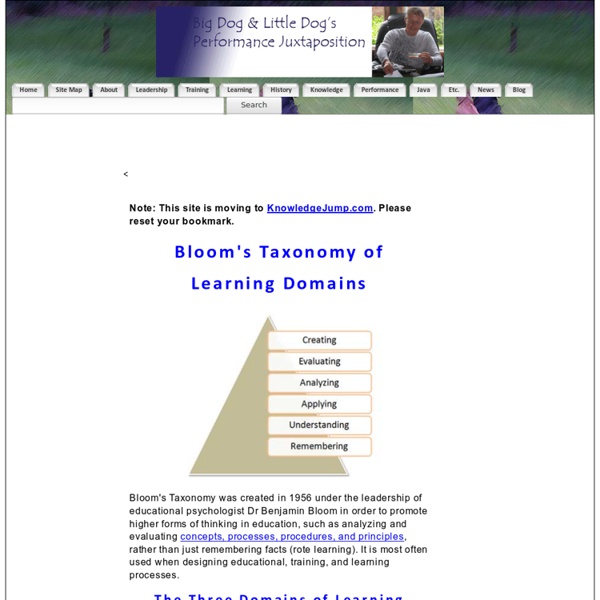bloom's taxonomy of learning domains - bloom's learning model, for teaching, lesson plans, training cousres design planning and evaluation
development of bloom's taxonomy Benjamin S Bloom (1913-99) attained degrees at Pennsylvania State University in 1935. He joined the Department of Education at the University of Chicago in 1940 and attained a PhD in Education in 1942, during which time he specialised in examining.
Transactional vs Transformational Relationships - Alignment Rockford
A transactional relationship is a relationship that will use people for their gifts or talent. Your needs come first ahead of anyone else. This isn’t necessarily a negative thing. Being transactional helps us to act in self-preserving ways, which is particularly important in a business sense. For example, when assigning tasks to group members, you want to make sure the tasks are assigned according to strength and expertise in that subject.
Bloom’s Taxonomy
Background Information | The Original Taxonomy | The Revised Taxonomy | Why Use Bloom’s Taxonomy? | Further Information The above graphic is released under a Creative Commons Attribution license. You’re free to share, reproduce, or otherwise use it, as long as you attribute it to the Vanderbilt University Center for Teaching. For a higher resolution version, visit our Flickr account and look for the “Download this photo” icon.
Definitions of Bloom's Taxonomy
Activities at Various Cognitive Levels of Learning (LoL) Bloom’s taxonomy of learning objectives is used to define how well a skill or competency is learned or mastered. A fuller description of Bloom’s taxonomy is given in the following pages but a brief summary of the activities associated with each level is given below.
Bloom’s Taxonomy - Educational Technology
Share on StumbleUpon0 shares on StumbleUpon Courses & Certification Instructional Design Certificate (Fully Online). This fully online program is for anyone developing and/or teaching an online course. Learn more... ADDIE Instructional Design Certificate Program (Fully Online). This fully online program is designed for individuals interested in learning more about the ADDIE model.
Creating Writing Assignments: Taxonomy of Objectives
Bloom et al.’s Taxonomy of Educational Objectives for the Cognitive Domain (1956) (with Outcome-Illustrating Verbs)* Designing Assignments Exercise in Assignment Design Using Bloom’s Taxonomy Knowledge Remembering (recalling) appropriate, previously learned information, such as terminology or specific facts. Verbs to use in assignments to have students demonstrate knowledge: define; describe; enumerate; identify; label; list; match; name; read; record; reproduce; select; state; view. Example: Ask your students to do a free-write in class, in which they identify three causes of the Civil War, or define Progressivism.
Anderson & Anderson's Change Model
Anderson & Anderson’s model of change provides a comprehensive coverage of the entire process of change and equally explains the whole process of change as a cyclical process (Anderson and Anderson, 2001, p. 13). This model briefly views change from three perspectives: Content: It analyzes the technical as well as the organizational factors which require change; People: This analyzes the subjective factors such as the mindset, changes in the behavioral patterns of people as well as the cultural changes; Process: This stage is related with the possible action plans or strategies that can be crafted and implemented for driving the change initaitive successfully across the organziation. All the three processes are integrated and interdependent on each other. The model is illustrated through nine phases as demonstrated in the diagram below: Source: Adapted from Anderson and Anderson (2001, p. 15)
Learning Outcomes
Most often we view results as the final outcome of an intervention that can easily be measured, such as reduced costs, customer satisfaction, improved quality, etc. However, often the results are going to be internal to the targeted individuals. These are known as learning outcomes or personal results. Kraiger, et. el. (1993) proposed that learning during training may be classified into one of three types of outcomes: cognitive, skill-based, and affective.
Major Categories in the Taxonomy of Educational Objectives
Knowledge remembering of previously learned material; of terminology; specific facts; ways and means of dealing with specifics (conventions, trends and sequences, classifications and categories, criteria, methodology); universals and abstractions in a field (principles and generalizations, theories and structures): Knowledge is (here) defined as the remembering (recalling) of appropriate, previously learned information. defines; describes; enumerates; identifies; labels; lists; matches; names; reads; records; reproduces; selects; states; views; writes;. Comprehension: Grasping (understanding) the meaning of informational materials. classifies; cites; converts; describes; discusses; estimates; explains; generalizes; gives examples; illustrates; makes sense out of; paraphrases; restates (in own words); summarizes; traces; understands.
The 6 Levels of Bloom’s Taxonomy Infographic - e-Learning ...
The 6 Levels of Bloom’s Taxonomy Infographic Benjamin Bloom, a renowned American education psychologist developed the taxonomy of learning objectives. Bloom’s taxonomy divides learning objectives into 3 domains namely; Cognitive Domain, Affective Domain, and Psychomotor Domain. Within the cognitive domain, objectives have been organizes into 6 levels. The 6 Levels of Bloom’s Taxonomy Infographic helps teachers understand these levels and see what type of learning each level addresses.
kolb's learning styles, experiential learning theory, kolb's learning styles inventory and diagram
We have some very exciting plans for Businessballs. Later this month, we will be launching a new visual identity, refreshing the design of the site and adding lots of new functionality to enhance your learning experience. Phase 2 will include badges, learning plans linked to accredited competency frameworks, wikis (for collaborative content development) and new content from international thought leaders and academics.



